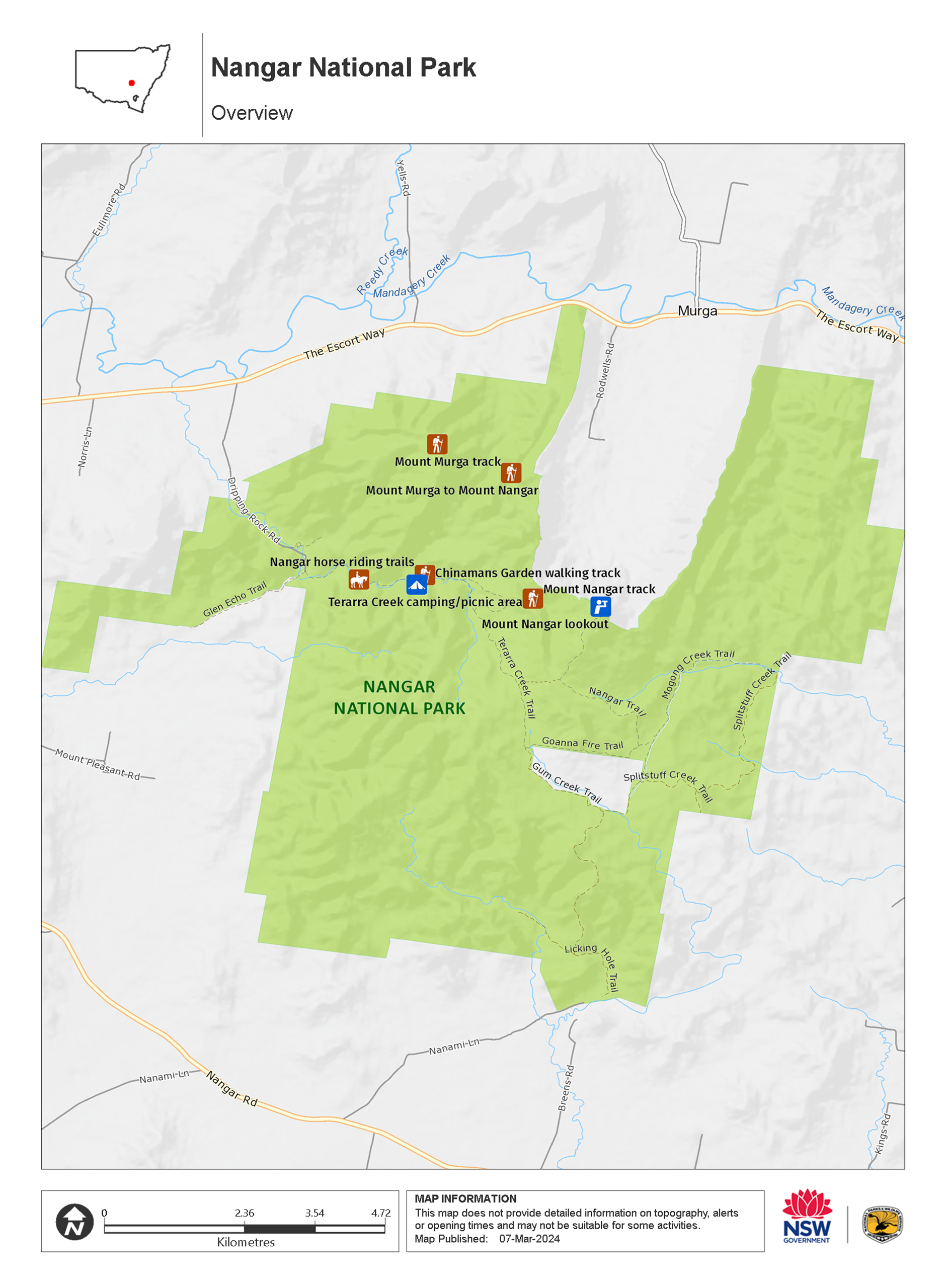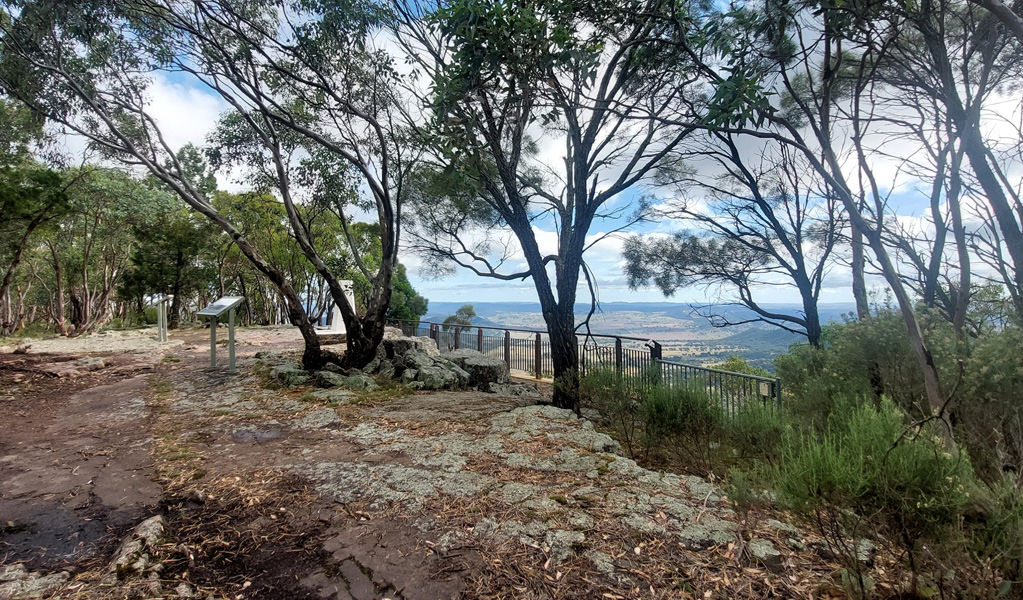Nangar National Park
Overview
Nestled in the farmlands of the central west are the dramatic peaks and ridges of Nangar, which offers scenic views, bushwalking, birdwatching, camping and picnicking.
Read more about Nangar National Park
Amid the wide open spaces of central west New South Wales, you'll find the spectacular scenery of Nangar National Park, dominated by the magnificent peak of Mount Nangar to the north. The park's beautiful wooded hills, easily accessible from Escort Way, create an ideal environment for picnicking, bushwalking and camping.
Whether you love wildflowers, birdwatching, photography or gazing up at a night sky brilliant with stars, there's plenty at Nangar to feed the soul. Autumn through to spring offers plenty of fresh and clear days to take long walks, and as the days become warmer, the land comes alive with colour. Don't miss Terarra Creek, lined with the gorgeous pink honey-myrtle. Keep your camera handy for kangaroos, wallabies, bats, peregrine falcons and wedge-tailed eagles, as well as the breathtaking cliff line and views from Mount Nangar .
Local alerts
For the latest updates on fires, closures and other alerts in this area, see https://www.nationalparks.nsw.gov.au/visit-a-park/parks/nangar-national-park/local-alerts
Contact
- in the Country NSW region
- Nangar National Park is always open but may have to close at times due to extreme weather or fire danger.
-
-
Bathurst office
02 6332 7640
02 6332 7680 To contact the KARST Conservation Unit in this office.
Contact hours: Monday to Friday, 8.30am to 4.30pm. - Level 2, 203-209 Russell Street, Bathurst NSW 2795
-
Email: npws.centralwest@environment.nsw.gov.au
-
Bathurst office
Visitor info
All the practical information you need to know about Nangar National Park.
Map

Map legend

Maps and downloads
Nearby towns
Forbes (40 km)
Rich in gold-mining history and the site of the biggest gold robbery in Australia's history, Forbes is renowned for its connections with notorious bushrangers Ben Hall and Frank Gardiner. Find out more on the town's heritage trail.
Orange (70 km)
The bustling city of Orange, with its many cafes, restaurants and shopping opportunities, has something for everyone, plus there's a huge range of places to stay. The real highlight is the town's food and wine, so bring your thirst and your appetite.
Learn more
Nangar National Park is a special place. Here are just some of the reasons why:
Wiradjuri country

A vast area of the central west of New South Wales, including Nangar National Park, is Wiradjuri country. Evidence suggests that Nangar Range has been an important landmark in Aboriginal culture and that the surrounding area was occupied for long periods. Places of significance include archaeological sites containing artefacts, stone scatters, quarries and scar trees.
Historic treasure

Gold was discovered around Eugowra in the 1860s, drawing miners and bushrangers, including the Gardener and Ben Hall gangs who roamed the area that the park now covers. Chinese miners lived here in the early 1900s, prospecting for copper. Historical remains in the park include remnants of gardens and orchards of Dripping Rock homestead, lost to fire in recent years, and its piggery, ruined hay shed and yards.
An ever-changing landscape

Ranging from the undulating hills in the south of the park to the long cliff line of red siltstone on the northern boundary - and the 770m-high Mount Nangar - the park offers a great variety of landscapes and views. Terarra Creek valley is open with wide creek flats and gentle slopes and the upper tributaries of Mogong Creek contains several natural springs. You'll see from the high vantage points of the park that the valley floor and more accessible lower slopes have been cleared by grazing and logging. Old growth forest is found in the steeper areas, but under national park protection, the park's vegetation communities will grow ever stronger.
- Mount Murga walking track Enjoy scenic views, spring wildflowers, varied wildlife and birdwatching on Mount Murga walking track; great for a day of bushwalking near Orange and Forbes.
- Mount Nangar walking track Mount Nangar walking track to the lookout takes you bushwalking through varied landscapes to scenic views over Nangar National Park and surrounding farmlands in search of wildlife and wildflowers.
A refuge for wildlife

Amid the extensive farmlands of the central west, Nangar is home to many sedentary and migratory birds and local native animals. Among many bird species are several birds of prey such as the peregrine falcon, wedge-tailed eagle and brown falcon, which use the cliff face along the northern boundary for nesting and perching. The park is also home to the eastern grey kangaroo, common wallaroo, red-necked wallaby, swamp wallaby, little mastiff-bat and chocolate wattled bat. You may also spot the southern rainbow skink, eastern long-necked tortoise and spotted grass frog.
- Mount Murga walking track Enjoy scenic views, spring wildflowers, varied wildlife and birdwatching on Mount Murga walking track; great for a day of bushwalking near Orange and Forbes.
- Mount Nangar walking track Mount Nangar walking track to the lookout takes you bushwalking through varied landscapes to scenic views over Nangar National Park and surrounding farmlands in search of wildlife and wildflowers.
Education resources (1)
What we're doing
Nangar National Park has management strategies in place to protect and conserve the values of this park. View the detailed park and fire management documents.
General enquiries
- National Parks Contact Centre
- 7am to 7pm daily
- 1300 072 757 (13000 PARKS) for the cost of a local call within Australia excluding mobiles
- parks.info@environment.nsw.gov.au
Contact
- in the Country NSW region
- Nangar National Park is always open but may have to close at times due to extreme weather or fire danger.
-
-
Bathurst office
02 6332 7640
02 6332 7680 To contact the KARST Conservation Unit in this office.
Contact hours: Monday to Friday, 8.30am to 4.30pm. - Level 2, 203-209 Russell Street, Bathurst NSW 2795
-
Email: npws.centralwest@environment.nsw.gov.au
-
Bathurst office

